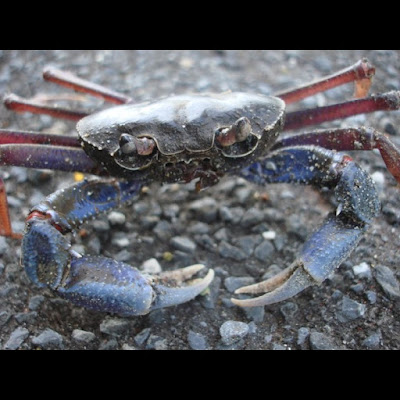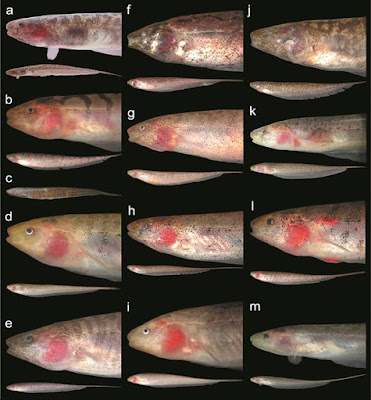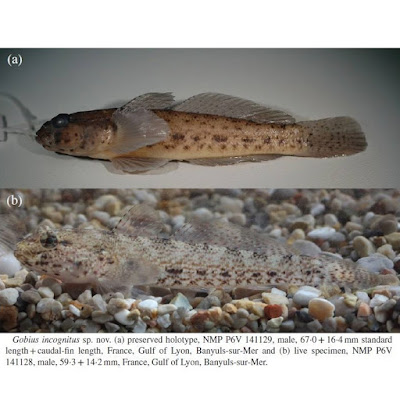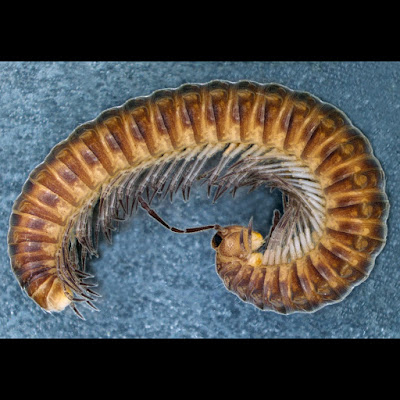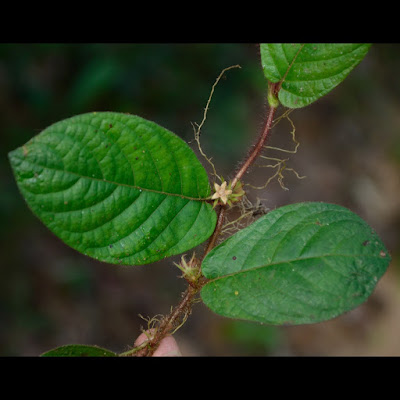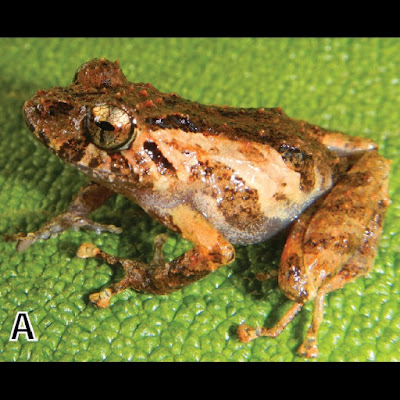[Most Recent Entries] [Calendar View]
Saturday, February 4th, 2017
| Time | Event | ||
| 6:52a | [Crustacea • 2016] Terrapotamon longitarsus • A New Species of Long-legged Terrestrial Terrapotamon Ng, 1986 (Brachyura: Potamidae) from Limestone Formations in Satun, southern Thailand
A new species of terrestrial potamid crab, Terrapotamon longitarsus, is described from limestone hills in Satun Province in southern Thailand. It is easily distinguished from other Terrapotamon species by its conspicuously long ambulatory legs (all congeners have proportionately short legs), relatively smooth dorsal surface of carapace, transversely narrow male thoracic sternites 1–4, and a characteristically structured male first gonopod. Keywords: Crustacea, comparative morphology, freshwater crab, Indochina, new species, Southeast Asia, systematics photos: Ronnaphon Engchuan Vachira Lheknim and Peter K.L. Ng. 2016. A New Species of Long-legged Terrestrial Terrapotamon Ng, 1986 (Crustacea: Brachyura: Potamidae) from Limestone Formations in Satun, southern Thailand. Zootaxa. 4200(1); 143–152. DOI: 10.11646/zootaxa.4200.1.6 | ||
| 7:05a | [Ichthyology • 2016] A Taxonomic Revision of the Neotropical Electric Fish Genus Brachyhypopomus (Gymnotiformes: Hypopomidae), with Descriptions of 15 New Species ABSTRACT The bluntnose knifefish genus Brachyhypopomus Mago-Leccia, 1994, is diagnosed from other Rhamphichthyoidea (Rhamphichthyidae + Hypopomidae) by the presence of a disk-like ossification in the anterior portion of the palatoquadrate, and by the following external characters: short snout, 18.7-32.6% of head length (vs. 33.3-68.6% in Hypopomus, Gymnorhamphichthys, Iracema, and Rhamphichthys), absence of a paired accessory electric organ in the mental or humeral region (vs. presence in Hypopygus and Steatogenys), presence of 3-4 pectoral proximal radials (vs. 5 in Akawaio), presence of the antorbital + infraorbital, and the preopercular cephalic lateral line canal bones (vs. absence in Racenisia). Brachyhypopomus cannot be diagnosed unambiguously from Microsternarchus or from Procerusternarchus on the basis of external characters alone. Brachyhypopomus comprises 28 species. Here we describe 15 new species, and provide redescriptions of all 13 previously described species, based on meristic, morphometric, and other morphological characters. We include notes on ecology and natural history for each species, and provide regional dichotomous keys and distribution maps, based on the examination of 12,279 specimens from 2,787 museum lots. A lectotype is designated for Brachyhypopomus pinnicaudatus (Hopkins, Comfort, Bastian & Bass, 1990). Brachyhypopomus species are abundant in shallow lentic and slow-flowing freshwater habitats from southern Costa Rica and northern Venezuela to Uruguay and northern Argentina. Species diversity is highest in Greater Amazonia, where 20 species occur: Brachyhypopomus alberti, new species, Brachyhypopomus arrayae, new species, and Brachyhypopomus cunia, new species, in the upper rio Madeira drainage; Brachyhypopomus batesi, new species, in the central Amazon and rio Negro; B. beebei, B. brevirostris, Brachyhypopomus regani, new species, Brachyhypopomus sullivani, new species, and B. walteri, widespread through the Amazon and Orinoco basins and the Guianas; Brachyhypopomus belindae, new species, in the central Amazon basin; Brachyhypopomus benjamini, new species, and Brachyhypopomus verdii, new species, in the upper Amazon basin; B. bennetti, in the upper, central, and lower Amazon, lower Tocantins, and upper Madeira basins; B. bullocki in the Orinoco, Negro and Essequibo drainages; B. diazi in the Orinoco Llanos; Brachyhypopomus flavipomus, new species, and Brachyhypopomus hamiltoni, new species, in the central and upper Amazon basin; Brachyhypopomus hendersoni, new species, in the central Amazon, lower Negro and Essequibo basins; B. pinnicaudatus in the central and lower Amazon, lower, upper Madeira, lower Tocantins and Mearim basins, and coastal French Guiana; and Brachyhypopomus provenzanoi, new species, in the upper Orinoco and upper Negro basins. Five species are known from the Paraná-Paraguay-Uruguay basin and adjacent southern Atlantic drainages: B. bombilla in the lower Paraná, upper, central, and lower Paraguay, Uruguay and Patos-Mirim drainages; B. brevirostris in the upper Paraguay basin; B. draco in the lower Paraná, lower Paraguay, Uruguay, Patos-Mirim, and Tramandaí basins; B. gauderio in the lower Paraná, upper, central, and lower Paraguay, Uruguay, Patos-Mirim and Tramandaí basins; and B. walteri in the lower Paraná and upper Paraguay basins. Two species occur in small Atlantic drainages of southern Brazil: B. janeiroensis in the São João, Paraíba and small intervening drainages; and B. jureiae in the Ribeira de Iguape and Una do Prelado. One species occurs in the middle and upper São Francisco basin: Brachyhypopomus menezesi, new species. Three species occur in trans-Andean drainages: B. diazi in Caribbean drainages of northern Venezuela; B. occidentalis in Atlantic and Pacific drainages of southern Costa Rica and Panama to Darién, and the Maracaibo, Magdalena, Sinú and Atrato drainages; and Brachyhypopomus palenque, new species, in Pacific drainages of Ecuador. Keywords: Biogeography; Bluntnose knifefish; Electroreception; Identification key; Rhamphichthyoidea Brachyhypopomus alberti, Brachyhypopomus arrayae, Brachyhypopomus batesi, Brachyhypopomus belindae, Brachyhypopomus benjamini, Brachyhypopomus cunia, Brachyhypopomus flavipomus, Brachyhypopomus hamiltoni, Brachyhypopomus hendersoni, Brachyhypopomus menezesi, Brachyhypopomus palenque, Brachyhypopomus provenzanoi Brachyhypopomus regani, Brachyhypopomus sullivani, Brachyhypopomus verdii Crampton, De Santana, Waddell, & Lovejoy, 2016 William G. R. Crampton, Carlos D. de Santana, Joseph C. Waddell and Nathan R. Lovejoy. 2016. A Taxonomic Revision of the Neotropical Electric Fish Genus Brachyhypopomus (Ostariophysi: Gymnotiformes: Hypopomidae), with Descriptions of 15 New Species. Neotropical Ichthyology. 14(4); DOI: 10.1590/1982-0224-20150146 RESUMO: Peixes elétricos do gênero Brachyhypopomus Mago-Leccia, 1994, são diagnosticados dos outros Rhamphichthyoidea (Rhamphichthyidae + Hypopomidae) pela presença de uma ossificação discóide na porção anterior do palatoquadrado, e pelos seguintes caracteres externos: focinho curto, 18,7-32,6% do comprimento da cabeça (vs. 33,3-68,6% em Hypopomus, Gymnorhamphichthys, Iracema e Rhamphichthys), ausência de um órgão elétrico acessório pareado na região mental ou humeral (vs. presença em Hypopygus e Steatogenys), presença de 3-4 proximais peitorais radiais (vs. 5 em Akawaio), presença do antiorbital + infraorbital, e dos canais ossificados da linha lateral da região cefálica do pré-opérculo (vs. ausência em Racenisia). Brachyhypopomus não pode ser diagnosticado de maneira não-ambígua de Microsternarchus ou Procerusternarchus, com base em caracteres de morfologia externa. Brachyhypopomus compreende 28 espécies válidas. Aqui nós descrevemos 15 espécies novas, e fornecemos a redescrição de 13 espécies previamente descritas, baseado em caracteres merísticos, morfométricos e outros caracteres morfológicos. Nós incluímos notas sobre à ecologia e história natural para cada uma das espécies, e fornecemos chaves dicotômicas regionais e mapas de distribuição baseado no exame de 12.279 espécimes de 2.787 lotes de museus. Um lectótipo é designado para Brachyhypopomus pinnicaudatus (Hopkins, Comfort, Bastian & Bass, 1990). Espécies de Brachyhypopomus são abundantes em habitats de águas rasas lênticas e com correntes fracas, ocorrendo do sul da Costa Rica e norte da Venezuela ao Uruguai e norte da Argentina. A diversidade de espécies é maior na Grande Amazônia, onde 20 espécies ocorrem: B. alberti, espécie nova, B. arrayae, espécie nova e B. cunia, espécie nova, na drenagem do alto rio Madeira; B. batesi, espécie nova, na Amazônia central e rio Negro; B. beebei, B. brevirostris, B. regani, espécie nova, B. sullivani, espécie nova e B. walteri, amplamente distribuídas nas bacias Amazônicas e do Orinoco, e nas Guianas; B. belindae, espécie nova, bacia Amazônica central; B. benjamini, espécie nova e B. verdii, espécie nova, na bacia do alto Amazonas; B. bennetti, no alto, médio e porções baixas da bacia Amazônica, baixo Tocantins e alto rio Madeira; B. bullocki nas drenagens do Orinoco, Negro e Essequibo; B. diazi nos Llanos do Orinoco; B. flavipomus, espécie nova e B. hamiltoni, espécie nova, no médio e alto Amazonas; B. hendersoni, espécie nova, na Amazônia central, baixo Negro e Essequibo; B. pinnicaudatus no médio e baixo Amazonas, baixo e alto Madeira, baixo Tocantins, bacia do Mearim e rios costeiros da Guiana Francesa; e B. provenzanoi, espécie nova, nas bacias do alto Orinoco e alto Negro. Cinco espécies são conhecidas das bacias Paraná-Paraguai-Uruguai e bacias adjacentes das drenagens do sul do Brasil: B. bombilla no alto, médio e baixo Paraguai, baixo Paraná, Uruguai e drenagens Patos-Mirim; B. brevirostris da bacia do alto Paraguai; B. draco das bacias do baixo Paraguai, baixo Paraná, Uruguai, Patos-Mirim e Tramandaí; B. gauderio das bacias do alto, médio e baixo Paraguai, baixo Paraná, Uruguai, Patos-Mirim e Tramandaí; e B. walteri das bacias do alto Paraguai e baixo Paraná. Duas espécies ocorrem nas drenagens costeiras do sudeste do Brasil: B. janeiroensis no São João, Paraíba e em drenagens menores nas adjacências; e B. jureiae no Ribeira de Iguape e Una do Prelado. Uma espécie ocorre no médio e alto rio São Francisco: B. menezesi, espécie nova. Três espécies ocorrem nas drenagens trans-Andinas: B. diazi nas drenagens do Caribe no norte da Venezuela; B. occidentalis nas drenagens do Atlantico e Pacífico do sul da Costa Rica e Panamá até Darién, e nas drenagens do Maracaibo, Magdalena, Sinú e Atrato; e B. palenque, espécie nova, nas drenagens do Pacífico no Equador. | ||
| 7:28a | [Ichthyology • 2016] Gobius incognitus • A New Species of Gobius (Perciformes: Gobiidae) from the Mediterranean Sea and the Redescription of Gobius bucchichi
Abstract A new species of the gobiid genus Gobius (Gobiidae, Perciformes), Gobius incognitus sp. nov. is described from the Mediterranean Sea, and its most morphologically similar species Gobius bucchichi is redescribed. The new species is distinguished from its congeners by: scales in lateral series 51–59; predorsal scales 25–35; opercle scaled in adults with 10–16 scales present; pectoral fin with ray count 18–20 and free tips on upper rays well developed and on the first ray longer than two thirds of the entire ray length; pelvic disc complete and with well-developed anterior membrane without lateral lobes; anterior oculoscapular canal with pore α at rear of orbit; oculoscapular row x1 not extending forwards to pore β; suborbital row d discontinuous with large gap below suborbital rows 3 and 4; eye diameter 1·08–1·32 in snout length; by pigment rows on cheek and pigmentation on pectoral-fin base. Diagnosis: Gobius incognitus sp. nov. is unique among species of Gobius by the following combination of characteristics: (1) LL 51–59; (2) PD 25–35; (3) opercle scaled in adults with 10–16 scales present; (4) P count 18–20; (5) free tips on upper P rays well developed and the first ray longer than two thirds of the entire ray length; (6) V disc complete; (7) V disc anterior membrane without lateral lobes; (8) anterior oculoscapular canal with pore α at rear of orbit; (9) oculoscapular row x1 not extending forwards to pore β; (10) suborbital row d discontinuous with large gap below suborbital rows 3 and 4; (11) eye diameter 1·08–1·32 in snout length; (12) the pigment dots on cheek irregularly scattered or, if rows are visible, then additional dots or a third row present across the middle of the cheek between the lower row starting anteriorly at the angle of mouth and the upper row that touches ventral margin of eye; (13) the upper mark on the P base single or doubled, reaching downwards to eighth to 10th rays counting from the upper part of fin. Etymology: The species name is from the Latin incognitus meaning unknown in reference to the long period of time that passed until this common and widespread species was recognized and described. Ecological and geographical distribution: The species was collected in the north, middle and south Adriatic Sea, in the north-western Mediterranean in France, Banyuls-sur-Mer and in the eastern Mediterranean at Crete Island and in Israel (Fig. 3). .... M. Kovačić and R. Šanda. 2016. A New Species of Gobius (Perciformes: Gobiidae) from the Mediterranean Sea and the Redescription of Gobius bucchichi. Journal of Fish Biology. 88(3); 1104–1124. DOI: 10.1111/jfb.12883 | ||
| 7:53a | [Diplopoda • 2016] The Millipede Family Anthroleucosomatidae (Diplopoda, Chordeumatida): The Caucasus as A Major Hotspot of Biodiversity
Abstract Fifteen new genera and 36 new species of the diplopod family Anthroleucosomatidae Verhoeff, 1899 are described from the Caucasus, one of the world’s biodiversity hotspots: Golovatchosoma bacillichaetum gen. et sp. nov., G. trichochaetum sp. nov., Alpinella waltheri gen. et sp. nov., Brachychaetosoma turbanovi gen. et sp. nov., Caucaseuma elephantum sp. nov., C. fanagoriyskaya sp. nov., C. glabroscutum sp. nov., C. kelasuri sp. nov., C. minellii sp. nov., C. variabile sp. nov., Caucasominorus billi gen. et sp. nov., C. polylobatus sp. nov., Georgiosoma bicornutum gen. et sp. nov., Heterocaucaseuma feminaepectorum gen. et sp. nov., H. longicorne sp. nov., Paranotosoma attemsi gen. et sp. nov., P. cordatum sp. nov., P. subrotundatum sp. nov., Dentatosoma denticulatum gen. et sp. nov., D. magnum sp. nov., D. zeraboseli sp. nov., Enghoffiella insolita gen. et sp. nov., Metamastigophorophyllon hamatum sp. nov., M. lamellohirsutum sp. nov., M. torsivum sp. nov., Acanthophorella barjadzei gen. et sp. nov., A. chegemi sp. nov., A. irystoni sp. nov., Cryptacanthophorella manubriata gen. et sp. nov., Flagellophorella hoffmani gen. et sp. nov., Pseudoflagellophorella eskovi gen. et sp. nov., P. mirabilis sp. nov., P. papilioformis sp. nov., Herculina oligosagittae gen. et sp. nov., H. polysagittae sp. nov., Vegrandosoma tabacarui gen. et sp. nov. All anthroleucosomatids from the Caucasus, both new and previously described, are classified in eight endemic complexes, arranged as follows in alphabetic order: the Alloiopus complex, the Caucaseuma complex, the Dentatosoma complex, the Enghoffiella complex, the Flagellophorella complex, the Herculina complex, the Ratcheuma complex and the Vegrandosoma complex. The genus Metamastigophorophyllon Ceuca, 1976 (the type-species: Mastigophorophyllon giljarovi Lang, 1959, adequately redescribed from new material), is a new subjective senior synonym of Persedicus Mauriès, 1982, syn. nov., being also newly transferred from the family Mastigophorophyllidae to the family Anthroleucosomatidae, comb. nov. The following two new combinations are also proposed: Heterocaucaseuma mauriesi (Golovatch and Makarov, 2011), comb. nov. ex Anamastigona Silvestri, 1898; and Metamastigophorophyllon martensi (Mauriès, 1982), comb. nov. ex Persedicus Mauriès, 1982. An identification key to and distribution maps for all known species of Caucasian Anthroleucosomatidae are provided, as well as brief remarks on distributions and on cave-dwelling taxa. Keywords: Myriapoda, Anthroleucosomatidae, Caucasus, taxonomy, new genera, new species, new synonymy, new combination Dragan Ž. Antić and Slobodan E. Makarov. 2016. The Caucasus as A Major Hotspot of Biodiversity: Evidence from The Millipede Family Anthroleucosomatidae (Diplopoda, Chordeumatida). Zootaxa. 4211(1); 1–205. DOI: 10.11646/zootaxa.4211.1.1 | ||
| 8:00a | [Botany • 2017] Taxonomic Revision of Sabicea Subgenus Anisophyllae (Ixoroideae, Rubiaceae) from Tropical Africa, with Four New Species
Abstract A taxonomic revision of Sabicea subgenus Anisophyllae (Rubiaceae), a group restricted to Central and East Africa, is presented here. This work, based on a study of herbarium specimens and field observations in Cameroon and Gabon, includes a survey of the morphological features of the group, a key to the species, descriptions of all the taxa, and IUCN conservation status assessments. Fifteen species are recognised, four of which are described as new (Sabicea mapiana, S. ndjoleensis, S. parmentierae, S. sciaphilantha), three former varieties are raised to species rank (S. crystallina, S. jacfelicis, S. tersifolia), and one species previously sunk into synonymy is restored (S. bequaertii). Two new infraspecific taxa are also described, Sabicea crystallina subsp. engongensis and S. sciaphilantha subsp. hirsuta. The group has its center of diversity in Gabon, where 10 of the 15 species occur, three of them being endemic to the country. Keywords: Conservation status, Guineo-Congolian Region, IUCN Red List Categories and Criteria, Lower Guinea, taxonomy, Rubiaceae, Sabicea, tropical African flora, Eudicots Lise L.A. Zemagho, Sigrid Liede-Schumann, Olivier Lachenaud, Steven Dessein and Bonaventure Sonke. 2017. Taxonomic Revision of Sabicea Subgenus Anisophyllae (Ixoroideae, Rubiaceae) from Tropical Africa, with Four New Species. Phytotaxa. 293(1); 1–68. DOI: 10.11646/phytotaxa.293.1.1 | ||
| 8:12a | [Herpetology • 2017] Pristimantis ashaninka • A New Species of Pristimantis (Anura, Craugastoridae) from A Montane Forest of the Pui Pui Protected Forest in central Peru (Región Junín) Abstract A new species of frog of the genus Pristimantis is described from a montane forest between 1700 and 1800 m a.s.l. of the Pui Pui Protected Forest (Región Junín) in central Peru. Pristimantis ashaninka sp. n. is described based on five adult females (snout–vent length 23.1–26.7 mm) and ten juveniles (snout-vent length 10.6–13.4). It differs from its congeners by having the skin on dorsum shagreen with many conical tubercles giving it a spinose appearance, lacking a tympanum, having groin, anterior and posterior surfaces of thighs uniformly grayish brown, and a pale bronze iris with fine black reticulations, a median reddish hint horizontally across iris, and a black narrow vertical streak from pupil across lower and upper half of iris. Among the Peruvian Pristimantis that lack a tympanum, P. ashaninka sp. n. is morphologically most similar to P. lirellus, P. martiae, and P. rhabdocnemus. However, 16S DNA barcoding revealed clear distinctions between all four species of Pristimantis. Keywords: Andes, montane forests, anuran diversity, Pristimantis ashaninka new species, Peru
Pristimantis ashaninka sp. n. Suggested English name: Asháninka Rubber Frog Suggested Spanish name: Rana cutín asháninka Pristimantis sp. Pui Pui in Lehr et al. (in press, Fig. 2) Etymology: The species epithet ashaninka is used in reference to the indigenous people Asháninka who inhabit forests in the Peruvian Regions Huánuco, Junín, Pasco, and Ucayali. Distribution, natural history, and threat status: Pristimantis ashaninka is only known from the type locality, which is located at the northeastern border of the Pui Pui Protected Forest, ca. 18 km (straight airline) NW of the town of Satipo, Distrito de Pichanaqui, Privincia de Chanchamayo, Región Junín, Peru (Fig. 1). The type locality lies in the valley of a tributary of the Rio Bravo at an elevation between 1700 and 1800 m a.s.l. and can be reached by walking in one and a half day starting at the village of Ayte (11°09‘46.7‘‘S, 74°55‘14‘‘W, 1295 m a.s.l.), which serves as a control station for the administration of the PPPF. The valley is surrounded by steep mountain slopes, which gives it a narrow character. The surrounding mountains are covered by a primary mountain rainforest characterized by 15–20 m high canopy and frequent occurrence of bromeliads, ferns, and epiphytic mosses. The adult specimens of P. ashaninka were collected at night on vegetation up to 150 cm above the ground whereas juveniles occupied lower positions in the vegetation. Other craugastorid species found at the type locality in sympatry with P. ashaninka included Pristimantis cf. albertus, P. bipunctatus (Duellman and Hedges, 2005), P. cruciocularis, P. cf. platydactylus, and Pristimantis sp. nov. According to the sparse data available, we here classify P. ashaninka as “Data Deficient” according to the IUCN red list criteria. Edgar Lehr and Jiří Moravec. 2017. A New Species of Pristimantis (Amphibia, Anura, Craugastoridae) from A Montane Forest of the Pui Pui Protected Forest in central Peru (Región Junín). ZooKeys. 645; 85-102. DOI: 10.3897/zookeys.645.11221 |
| << Previous Day |
2017/02/04 [Calendar] |
Next Day >> |
